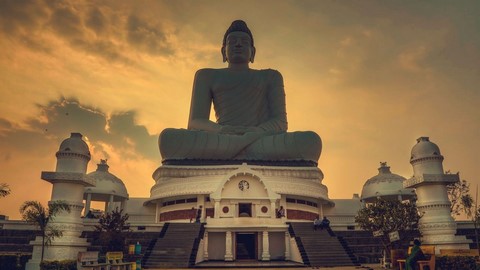
IRCTC’s Buddhist Circuit Tourist Train offers tourists and history enthusiasts a chance to journey to prominent Buddhist heritage sites of India across many cities. These locations include but are not limited to the following:
BODHGAYA
Being the city where the Buddha gained enlightenment, Bodhgaya is a very important Buddhist pilgrimage site from both religious and historic perspectives and offers many attractions.
Mahabodhi Temple
The Mahabodhi Temple is an ancient Buddhist temple that marks the location where the Buddha attained enlightenment. The World UNESCO Heritage Site is located in the east of the Mahabodhi Tree and is quite an architectural sight.
Thai Temple
The Thai Monastery is arguably the most prominent among all the international monasteries built by various nationals. It stands out for its stunning architecture, golden roof, Thai Temple and a 25-metre-high bronze Buddha statue.
Japanese Temple
The Japanese Temple resembles a Japanese shrine and is a fine example of Japanese architecture and Buddhist culture. Carved out of wood, it was built to preserve and propagate Buddhism and its values. Its gallery houses paintings depicting the most important events of Buddha’s life.
Buddha Statue
Consecrated on 18 November 1989 by the 14th Dalai Lama, the 80 Feet Buddha Statue is one of the main attractions for both tourists and pilgrims. The statue was built with a mix of sandstone blocks and red granite.
RAJGIR
Rajgir is one of the major Buddhist pilgrimage sites for its relation to the Buddha. It was also the first seat of power in the ancient kingdom of Magadha.
Bimbisara Jail
Bimbisara Jail gets its name from King Bimbisara, the founder of the Haryanka dynasty and a staunch disciple of the Buddha. According to Buddhist literature, he was imprisoned at this place by his son Ajatshatru. It is said that when he was asked to choose a spot for his imprisonment, he chose somewhere he could see the Buddha.
Gridhakuta Hill
Gridhakuta Hill literally means Vulture Peak and indeed resembles the bird’s head. It is where Gautama Buddha preached many inspiring sermons and it was his favourite meditation site.
Venuvan
Venuvan is considered Magadhan King Bimbisara’s first offering to the Lord. It’s said that the King was once locked out of Rajgir due to being delayed and spent the night with Gautama Buddha here.
NALANDA
Nalanda is one of the prime tourist hotspots of the state of Bihar as home to one of the oldest centres of learning.
Ruins of Nalanda University
The 5th-century university at Nalanda was an epicentre of learning of ancient India with several subjects including Buddhist scriptures of Mahayana and Hinayana schools taught here.
Nalanda Museum
The museum houses many relics recovered from the Nalanda ruins and is a must-visit for those who wish to explore the history of Buddhism.
SARNATH
Sarnath is a highly revered pilgrimage centre as the site of Buddha’s first sermon after enlightenment.
Dhamek Stupa
The most noticeable Buddhist structure in the area, Dhamek Stupa was built in 500 CE as a replacement to the original structure built by the Mauryan Emperor Asoka in 249 BCE. Representing the deer park where the Buddha revealed his Eightfold Path to his disciples, the stupa is 28 metres in diameter and 43.6 metres in height.
Sarnath Museum
The museum displays antiquities recovered from the excavation of the Sarnath site dating from the third century BCE to the 12th century AD.
Mulgandha Kuti Vihar
Built by the Maha Bodhi Society of India, the Mulgandha Kuti Vihar features the original golden statue in the preaching pose along with the Buddha’s other relics.
KUSHINAGAR
As the city where the Buddha attained Nirvana, Kushinagar is one of the top Buddhist pilgrimage sites in India with several tourist attractions.
Mahaparinirvana Temple
The Mahaparinirvana Temple is the prime tourist attraction of Kushinagar with its reclining Buddha statue that is 6.1 metres long and represents him dying. The statue faces west, further cementing the idea of the sunset of his life. Many relics of the past were excavated from the site.
Rambhar Stupa
The Ramabhar Stupa demarcates the location of Lord Buddha’s cremation by the ancient Malla people. The stupa was built over a portion of his ashes and stands around 50 ft tall.
SRAVASTI
The site of the Budha’s greatest miracles, Sravasti has some of the most significant Buddhist heritage sites of India.
Pakki Kuti
Identified as the remains of the stupa of Angulimala, Pakki Kuti is one of the largest mounds found in the Mahet area. It seems to be a terraced stupa built on a rectangular plan.